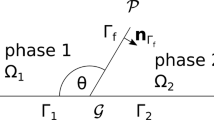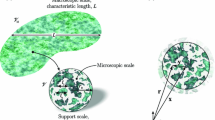Abstract
For a non-isothermal reactive flow process, effective properties such as permeability and heat conductivity change as the underlying pore structure evolves. We investigate changes of the effective properties for a two-dimensional periodic porous medium as the grain geometry changes. We consider specific grain shapes and study the evolution by solving the cell problems numerically for an upscaled model derived in Bringedal et al. (Transp Porous Media 114(2):371–393, 2016. doi:10.1007/s11242-015-0530-9). In particular, we focus on the limit behavior near clogging. The effective heat conductivities are compared to common porosity-weighted volume averaging approximations, and we find that geometric averages perform better than arithmetic and harmonic for isotropic media, while the optimal choice for anisotropic media depends on the degree and direction of the anisotropy. An approximate analytical expression is found to perform well for the isotropic effective heat conductivity. The permeability is compared to some commonly used approaches focusing on the limiting behavior near clogging, where a fitted power law is found to behave reasonably well. The resulting macroscale equations are tested on a case where the geochemical reactions cause pore clogging and a corresponding change in the flow and transport behavior at Darcy scale. As pores clog the flow paths shift away, while heat conduction increases in regions with lower porosity.















Similar content being viewed by others
References
Agosti, A., Formaggia, L., Scotti, A.: Analysis of a model for precipitation and dissolution coupled with a Darcy flux. J. Math. Anal. Appl. 431, 752–781 (2015a). doi:10.1016/j.jmaa.2015.06.003
Agosti, A., Formaggia, L., Giovanardi, B., Scotti, A.: MOX-report no. 08/2015, numerical simulation of geochemical compaction with discontinuous reactions. Tech. Rep., MOX, Politecnico di Milano (2015b)
Bringedal, C., Berre, I., Radu, F.A.: An approach for investigation of geochemical rock-fluid interactions. In: Proceedings, Thirty-Ninth Workshop on Geothermal Reservoir Engineering, Stanford University (2014)
Bringedal, C., Berre, I., Pop, I.S., Radu, F.A.: A model for non-isothermal flow and mineral precipitation and dissolution in a thin strip. J. Comput. Appl. Math. 289, 346–355 (2015). doi:10.1016/j.cam.2014.12.009
Bringedal, C., Berre, I., Pop, I.S., Radu, F.A.: Upscaling of non-isothermal reactive porous media flow with changing porosity. Transp. Porous Media 114(2), 371–393 (2016). doi:10.1007/s11242-015-0530-9
Chadam, J., Hoff, D., Merino, E., Ortoleva, P., Sen, A.: Reactive infiltration instabilities. IMA J. Appl. Math. 36(3), 207–221 (1986)
Chadam, J., Peirce, A., Ortoleva, P.: Stability of reactive flows in porous media: coupled porosity and viscosity changes. SIAM J. Appl. Math. 51(3), 684–692 (1991)
COMSOL Inc. Version 4.2. http://www.comsol.com (2011)
Duval, F., Fichot, F., Quintard, M.: A local thermal non-equilibrium model for two-phase flows with phase-change in porous media. Int. J. Heat Mass Transf. 47(3), 613–639 (2004)
Frank, F.: Numerical studies of models for elektrokinetic flow and charged solute transport in periodic porous media. Ph.D. thesis, Friedrich-Alexander-Universität Erlangen-Nürnberg (FAU) (2013)
Frank, F., Ray, N., Knabner, P.: Numerical investigation of homogenized Stokes-Nernst-Planck-Poisson systems. Comput. Vis. Sci. 14(8), 385–400 (2011)
Knabner, P., van Duijn, C.J., Hengst, S.: An analysis of crystal dissolution fronts in flows through porous media. Part 1: compatible boundary conditions. Adv. Water Resour. 18(3), 171–185 (1995)
Kumar, K., van Noorden, T.L., Pop, I.S.: Effective dispersion equations for reactive flows involving free boundaries at the microscale. Multiscale Model. Simul. 9(1), 29–58 (2011)
Kumar, K., Pop, I.S., Radu, F.A.: Convergence analysis of mixed numerical schemes for reactive flow in a porous medium. SIAM J. Numer. Anal. 51(4), 2283–2308 (2013a)
Kumar, K., Wheeler, M.F., Wick, T.: Reactive flow and reaction-induced boundary movement in a thin channel. SIAM J. Sci. Comput. 35(6), B1235–B1266 (2013b)
Kumar, K., Pop, I.S., Radu, F.A.: Convergence analysis for a conformal discretization of a model for precipitation and dissolution in porous media. Numer. Math. 127(4), 715–749 (2014)
Kumar, K., Neuss-Radu, M., Pop, I.S.: Homogenization of a pore scale model for precipitation and dissolution in porous media. IMA J. Appl. Math. 81(5), 877–897 (2016)
Libbey, R.B., Williams-Jones, A.E.: Relating sulfide mineral zonation and trace element chemistry to subsurface processes in the Reykjanes geothermal system. Iceland. J. Volcanol. Geotherm. Res. 310, 225–241 (2016)
McNamara, D.D., Lister, A., Prior, A.J.: Calcite sealing in a fractured geothermal reservoir: insights from combined EBSD and chemistry map**. J. Volcanol. Geotherm. Res. 323, 38–52 (2016)
Mielke, P., Nehler, M., Bignall, G., Sass, I.: Thermo-physical rock properties and the impact of advancing hydrothermal alteration-a case study from the Tauhara geothermal field. New Zealand. J. Volcanol. Geotherm. Res. 301, 14–28 (2015)
Mroczek, E.K., White, S.P., Graham, D.J.: Deposition of amorphous silica in porous packed beds predicting the lifetime of reinjection aquifers. Geothermics 29(6), 737–757 (2000)
Nield, D.A., Bejan, A.: Convection in Porous Media, 4th edn. Springer, Berlin (2013)
Pape, H., Clauser, C., Iffland, J., Krug, R., Wagner, R.: Anhydrite cementation and compaction in geothermal reservoirs: interaction of pore-space structure with flow, transport, p-t conditions, and chemical reactions. Int. J. Rock Mech. Min. Sci. 42(7), 1056–1069 (2005)
Peter, M.A.: Coupled reaction-diffusion processes inducing an evolution of the microstructure: analysis and homogenization. Nonlinear Anal. Theory Methods Appl. 70(2), 806–821 (2009)
Ray, N., van Noorden, T.L., Radu, F.A., Friess, W., Knabner, P.: Drug release from collagen matrices including an evolving microstructure. ZAMM J. Appl. Math. Mech. 93(10–11), 811–822 (2013)
Schulz, R., Ray, N., Frank, F., Mahalo, H.S., Knabner, P.: Strong solvability up to clogging of an effective diffusion-precipitation model in an evolving porous medium. Eur. J. Appl. Math. 28, 1–29 (2016)
Sonnenthal, E., Ito, A., Spycher, N., Yui, M., Apps, J., Sugita, Y., Conrad, M., Kawakami, S.: Approaches to modeling coupled thermal, hydrological, and chemical processes in the drift scale heater test at yucca mountain. Int. J. Rock Mech. Min. Sci. 42(5), 698–719 (2005)
Taron, J., Elsworth, D.: Thermal-hydrologic-mechanical-chemical processes in the evolution of engineered geothermal reservoirs. Int. J. Rock Mech. Min. Sci. 46, 654–855 (2009)
Torquato, S.: Random Heterogeneous Materials: Microstructure and Macroscopic Properties. Springer, Berlin (2013)
van Duijn, C.J., Knabner, P.: Travelling wave behavior of crystal dissolution in porous media flow. Eur. J. Appl. Math. 8, 49–72 (1997)
van Duijn, C.J., Pop, I.S.: Crystal dissolution and precipitation in porous media: pore scale analysis. Journal für die reine und angewandte Matematik 577, 171–211 (2004)
van Noorden, T.L., Pop, I.S., Röger, M.: Crystal dissolution and precipitation in porous media: L1-contraction and uniqueness. In: Discrete Contin. Dyn. Syst. (Dynamical Systems and Differential Equations. Proceedings of the 6th AIMS International Conference, Suppl.), pp. 1013–1020 (2007)
van Noorden, T.L.: Crystal precipitation and dissolution in a porous medium: effective equations and numerical experiments. Multiscale Model. Simul. 7(3), 1220–1236 (2009a)
van Noorden, T.L.: Crystal precipitation and dissolution in a thin strip. Eur. J. Appl. Math. 20, 69–91 (2009b)
van Noorden, T.L., Pop, I.S., Ebigbo, A., Helmig, R.: An upscaled model for biofilm growth in a thin strip. Water Resour. Res. 46(6) (2010). doi:10.1029/2009WR008217
Verma, A., Pruess, K.: Thermohydrological conditions and silica redistribution near high-level nuclear wastes emplaced in saturated geological formations. J. Geophys. Res. Solid Earth (1978–2012) 93(B2), 1159–1173 (1988)
Wagner, R., Kühn, M., Meyn, V., Pape, H., Vath, U., Clauser, C.: Numerical simulation of pore space clogging in geothermal reservoirs by precipitation of anhydrite. Int. J. Rock Mech. Min. Sci. 42(7), 1070–1081 (2005)
White, S.P., Mroczek, E.K.: Permeability changes during the evolution of a geothermal field due to the dissolution and precipitation of quartz. Transp. Porous Media 33(1–2), 81–101 (1998)
Woodside, W.M.J.H., Messmer, J.H.: Thermal conductivity of porous media. I. Unconsolidated sands. J. Appl. Phys. 32, 1688–1699 (1961)
Xu, T., Rose, P., Fayer, S., Pruess, K.: On modeling of chemical stimulation of an enhanced geothermal system using a high pH solution with chelating agent. Geofluids 9, 167–177 (2009)
Xu, T., Spycher, N., Sonnenthal, E., Zheng, L., Pruess, K.: TOUGHREACT user’s guide: a simulation program for non-isothermal multiphase reactive transport in variably saturated geologic media, version 2.0. Earth Sciences Division, Lawrence Berkeley National Laboratory, Berkeley, USA (2012)
Zhao, C.: Physical and Chemical Dissolution Front Instability in Porous Media: Theoretical Analyses and Computational Simulations. Springer, Berlin (2014)
Acknowledgements
K. Kumar acknowledges the support by the Research Council of Norway under the project IMMENS no. 255426 and “EOR upscaling—from lab to field”, Petromaks 2 project. The authors would like to thank Nadja Ray and Raphael Schulz from FAU Erlangen-Nürnberg for their useful discussions supported by the Research Council of Norway (RCN) and German Academic Exchange Service (DAAD) Project No. 255773, “Upscaling Evolving Microstructures and its Applications”.
Author information
Authors and Affiliations
Corresponding author
Appendix
Appendix
Section 4.1 deals with analytical solutions of an approximate heat conductive cell problem, and we here give the derivation of these solutions. We seek the unknown functions \(\Theta _f(y_1,y_1)\) and \(\Theta _g(y_1,y_2)\) that should fulfill Eq. (3b) together with periodicity across the external cell boundary:
We use polar coordinates and assume separation of variables; hence, the solutions can be written
Then, the model equations from (3b) are
while the interior boundary conditions can be written as
and for all \(\theta \). The model equations for \(F_{\theta }\) and \(G_{\theta }\) reduce to \(F_{\theta }'' = -\lambda F_{\theta }\) for some number \(\lambda \), which, together with the interior boundary condition (8a), suggest that
The model equations for \(F_r\) and \(G_r\) are then reduced to \(r^2F''_r+rF'_r-F_r=0,\) which have the general solutions
where \(b_1, b_2, b_3, b_4\) are integration constants. However, our assumption of separation of variables together with the solution in \(\theta \) leads to the periodicity requirement on the external boundary not being fulfilled. There is periodicity across the horizontal boundaries, but periodicity across the vertical boundaries is not met. We instead search an approximate solution through alternative boundary conditions for the external boundary and consider two approaches: either drop** the external boundary and allowing \(\Theta _f\) to be well defined for all \(r>R\); or, kee** the boundary, but neglecting the boundary conditions and using other means to determine the constants \(b_1,b_2,b_3,b_4\).
1.1 Alternative I: Infinite Domain
We allow \(\Theta _f\) to be defined for all \(r>R\); hence, we require it to be finite as \(r\rightarrow \infty \). Also, as \(\Theta _g\) must be well defined as \(r\rightarrow 0\), the general solutions in r are
Applying the internal boundary conditions (8) results in \(b_2=R^2(1-\kappa )/(1+\kappa )\) and \(b_3=(1-\kappa )/(1+\kappa )\). Hence, the solutions of the approximate cell problem are
The approximate heat conductivity coefficients are then
Although \(\Theta _f\) is now defined for all \(r>R\), the original integration area for \({\mathcal {A}}_f\) is used. As we made an error by allowing \(\Theta _f\) to exist as \(r\rightarrow \infty \), and as we know the sum of \({\mathcal {A}}_f\) and \({\mathcal {A}}_g\) should be 1 when in the finite pore space domain, our above approximation can be improved by scaling the above coefficients with the same number such that their sum is 1. Hence,
1.2 Alternative II: No Periodic Boundary Condition
In this approach, we keep the external boundary but do not require periodicity across it. We still require \(\Theta _g\) to be well defined as \(r\rightarrow 0\), and hence \(b_4=0\) and the three remaining constants must be such that they fulfill the two internal boundary conditions (8):
Expressing \(b_2,b_3\) as functions of \(b_1\) leads to
The solutions of the (approximate) cell problem are then
where the constant \(b_1\) is to be determined later. The heat conductivities are then
We now require the sum \({\mathcal {A}}_f + {\mathcal {A}}_g\) to be 1 and use this to determine \(b_1\). This way,
Although this derivation uses different assumptions than Alternative I, the resulting approximate heat conductivity coefficients \({\mathcal {A}}_f\) and \({\mathcal {A}}_g\) found in (9) and (10) are identical.
Rights and permissions
About this article
Cite this article
Bringedal, C., Kumar, K. Effective Behavior Near Clogging in Upscaled Equations for Non-isothermal Reactive Porous Media Flow. Transp Porous Med 120, 553–577 (2017). https://doi.org/10.1007/s11242-017-0940-y
Received:
Accepted:
Published:
Issue Date:
DOI: https://doi.org/10.1007/s11242-017-0940-y




